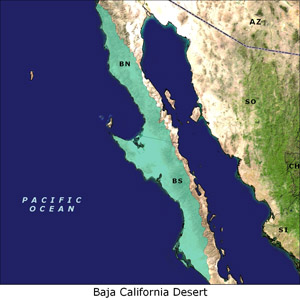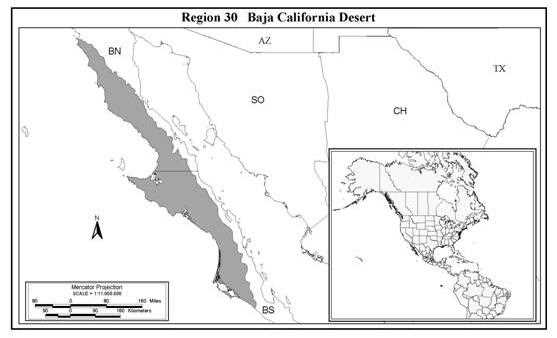Level III Ducks Unlimited conservation priority area, host to thousands of Pacific Flyway shorebirds during the winter and migration

The west coast of the peninsula of Baja California is adorned with a series of wetlands in near-pristine conditions. These areas play a major role for migratory birds on the Pacific Flyway, hosting thousands of shorebirds during the winter and on migration. They provide calving grounds for the gray whale, are the principal wintering area for Pacific black brant and contain endemic and endangered species of plants and animals. DU Mexico works in close cooperation with the municipal, state and federal government in Mexico as well as local non-governmental organizations, to protect the habitats of the Baja Peninsula. The support of DU on the development and implementation of management plans for these areas is key to securing protection in harmony with sustainable use and development of these sites.


The West Coast of the Peninsula of Baja California (Region 30*) is adorned with a series of wetlands in near-pristine conditions. These areas play a major role for migratory birds on the Pacific Flyway, hosting thousands of shorebirds during the winter and on migration (Kjelmyr et al. 1991). They provide calving grounds for the gray whale, are the principal wintering area for Pacific black brant (Saunders and Saunders 1981) and contain endemic and endangered species of plants and animals. These wetlands also provide breeding habitat for many seabirds including several endangered and threatened species (Palacios and Alfaro 1991; Zembal and Masey 1981).
The Baja Peninsula is 50-250 km wide and 1,500 km long. The majority of the habitat for waterfowl consists of bays and estuaries along the pacific coast (Kramer and Migoya 1989). Four bays, San Quintin, Scammon´s, San Ignacio and Magdalena, constitute the major distribution areas for 85% of the North American population of the Pacific black brant. These bays are hypersaline, intertidal, shallow and dominated by 58,875 ha of eelgrass beds (Carrera and de la Fuente, in press). Red, white and black mangroves are present on 34,601 ha of the bays.
Importance to waterfowl
In 1998, 164,848 waterfowl were distributed along the Baja Peninsula, of which 108,018 were Pacific brant and 56,830 were ducks of which 4,085 were dabblers (northern pintail, shoveler and American wigeon), 26,235 were divers (redhead, scaup and bufflehead) and 26,510 were sea ducks (scoters and mergansers). Over 80% of the Pacific brant population winters in the Pacific coast of Mexico, and most of the Mexican wintering population (>70%) is found along the west coast of Baja California at three areas; San Quintin, Scammon´s and San Ignacio Lagoons. The rest of the population is scattered along the west coast of mainland Mexico, in the states of Sonora and Sinaloa, from the Infiernillo Canal to Santa Maria Bay north. According to USFWS surveys, brant use of the Mexican west coast has increased significantly from 84% of the total North American population in the 1960s, to 92.3% in the 1970s and 93% during the 1980s, distributed mainly on these three main Bays.
Importance to other wildlife
Scammon's, San Ignacio and Magdelana Bays are important calving grounds for the gray whale in the winter. In 1998, Scammon´s Bay (Ojo de liebre) was declared to be a Biosphere Reserve under the protection of the federal government. In 1993, San Ignacio Bay was declared as a World Human Patrimony. Both designations are intended to contribute to the future conservation of these areas.
Canadian Wildlife Service surveys in the Northwest and Baja California coastline during 1992 recorded a total of 815,531 shorebirds, with almost 86% occurring in four key wetlands, in which Scammon´s Lagoon (Ojo de Liebre) accounted for 31.5% (Morrison et al. 1992). San Quintin and Scammon's Bays provide habitat for the endangered clapper rail which uses the 7,350 ha of saltmarsh cordgrass (Spartina foliosa) within these bays. The four bays provide habitat for 17,295 brown pelican, 605 white pelican and 148 osprey (USFWS 1997). San Ignacio Lagoon provides the most important nesting habitat for the ospreys along the coast of Baja California. Shoreline habitats such as mangroves support several colonies of nesting magnificent frigatebirds and several species of herons and egrets.
*Region 30 - NABCI Bird Conservation Region 38 (Baja California portion only)
DUMAC works in close cooperation with the municipal, state and federal government in Mexico, to protection of the habitats of the Baja Peninsula. This work is accomplished in cooperation with local non-government institutions. These relationships must be strengthened especially on those areas that are currently protected by the federal government. The support of DU on the development and implementation of management plans for these areas is key to securing protection in harmony with sustainable use and development of these sites. DU should develop proposals and partnerships on those sites with no existing protection. This can be done directly by DU or by supporting the work that is currently underway by local institutions.
Research is needed to determine how these areas function as ecosystems to help guide decisions on projects that may harm the natural conditions of the bays. For example, a resort development is planned in the San Quintin Bay along the barrier island which will involve dredging to build a marina for boats. In San Ignacio Bay the most important salt production industry in Latin America may also be expanded in future years. In both cases, the deterioration of the natural habitats is possible. DU must build strong relationships with local and national research institutions and universities to help guide the research needed to guide the conservation and management of the Bays. A good example is the partnership that has been developed between DU with CICESE, University of Baja California, the USGS-Alaska Science Center and the University of Alaska - Fairbanks to conduct research on the major bays along the Baja California to support their future use by Pacific brant.
DU recently finished the wetlands inventory and classification of the major habitats for waterfowl along the pacific coast of Baja California. The distribution of this information is key to support other institutions conservation and management initiatives. DU has initiated this process, by providing information to Proesteros, a local NGO in Baja that is working to conserve the natural values of San Quintin Bay. The opportunities and needs for leadership in conservation in this region are enormous. The establishment of partnerships is essential to guarantee the delivery of programs needed to preserve these four crucial wetlands for waterfowl in Mexico.
Ducks Unlimited uses cookies to enhance your browsing experience, optimize site functionality, analyze traffic, and deliver personalized advertising through third parties. By continuing to use this site, you agree to our use of cookies. View Privacy Policy